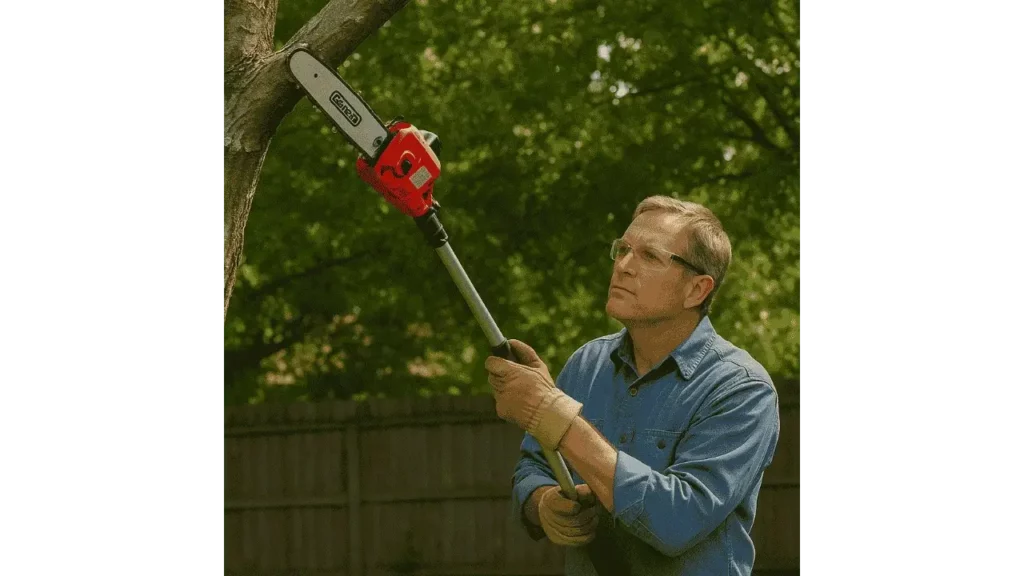Pole saws are designed to solve a very specific problem: how to trim high branches safely and efficiently. Rather than climbing ladders with a chainsaw in hand, a pole saw allows you to stay on solid ground while reaching limbs ten feet or higher. Whether you’re a homeowner managing backyard trees or a landscaper tackling routine maintenance, these tools offer a practical way to prune with precision and safety. Their ability to handle hard-to-reach areas makes them a standout choice for outdoor cutting tasks.

Why Choose a Pole Saw?
Pole saws are essentially chainsaws mounted on the end of a pole. They are designed to trim or cut tree branches that are too high to reach from the ground. This eliminates the need for climbing ladders, reducing the risk of accidents. Pole saws are widely used for light to medium-duty pruning and can reach up to 15 feet or more, depending on the model.
Unlike traditional chainsaws, pole saws provide convenience, efficiency, and an added layer of safety for basic tree care.
“A well-balanced pole saw can make regular pruning quick and manageable for homeowners,” explains Derek Langston, a certified arborist based in Vermont.
Do Pole Saws Really Cut Well?
Yes, pole saws can effectively cut branches ranging from small twigs to limbs several inches thick. Most models are equipped with either a small chainsaw blade or a manual pruning saw at the end of a telescoping or fixed pole. Electric and gas-powered versions deliver more cutting power and are suitable for heavier tasks, while manual models are better for light pruning.
Their cutting efficiency depends on proper maintenance, sharp blades, and the type of wood being cut. For example, freshly fallen or green branches are easier to cut than dry, aged wood. With proper technique, pole saws can produce clean cuts without splintering the wood.
Just In: Proyama Gas Chainsaw Review
Are Pole Saws Easy to Use?
For the average user, pole saws are relatively straightforward to operate. Telescoping models allow you to adjust the length based on the branch height, and ergonomic grips help reduce fatigue during extended use. Lightweight models are easier to maneuver but may have limited reach or cutting power.
Using a pole saw does require some upper body strength and coordination, especially when aiming the saw at awkward angles. Safety gear, such as gloves, goggles, and a helmet, is strongly recommended during use to protect against falling debris.
“Proper form and positioning are key to using a pole saw effectively and safely,” notes Angela Thomas, landscape maintenance instructor at GreenTech Training School.
Limitations of Pole Saws
While pole saws are excellent for pruning higher branches, they’re not ideal for cutting large tree trunks or branches thicker than six inches. They also may not perform well in dense, tightly packed canopies where visibility and movement are restricted.
Battery-operated or electric models may struggle with thick hardwood or extended use, and gas-powered models, while powerful, are heavier and noisier. It’s important to match the tool with the task to avoid overexertion or poor results.
Final Takeaways
Pole saws are highly effective tools for pruning and maintaining trees without climbing a ladder. Their design offers safety and convenience, especially when dealing with light to moderate trimming jobs. With the right model and proper care, a pole saw can make tree maintenance easier, safer, and more efficient. Understanding their strengths and limitations helps ensure you’re using the tool to its full potential while maintaining the health and appearance of your trees.
- How to Cut a Straight Line with a Jigsaw? - October 31, 2025
- How to Cut a Circle with a Jigsaw? - October 31, 2025
- Can You Cut Acrylic with a Jigsaw? - October 31, 2025
